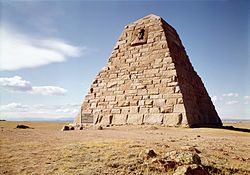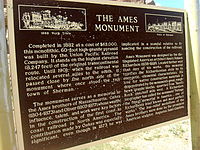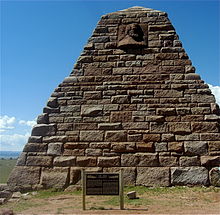- Ames Monument
-
Ames Monument
 Ames Monument
Ames MonumentLocation: Albany County, Wyoming, 3 mi (4.8 km) NW of Sherman Nearest city: Laramie, Wyoming Coordinates: 41°7′52″N 105°23′53″W / 41.13111°N 105.39806°WCoordinates: 41°7′52″N 105°23′53″W / 41.13111°N 105.39806°W Built: 1880 Architect: H. H. Richardson NRHP Reference#: 72001296 Added to NRHP: July 24, 1972 The Ames Monument is a large pyramid in Albany County, Wyoming, designed by Henry Hobson Richardson and dedicated to brothers Oakes Ames and Oliver Ames, Jr., Union Pacific Railroad financiers. The brothers garnered credit for connecting the nation by rail upon completion of the United States' First Transcontinental Railroad in 1869. Oakes, a U.S. representative to the United States Congress from Massachusetts, asserted near total control of its construction, whereas Oliver became president of the Union Pacific Railroad (1866 - 1871).[1] In 1873 investigators implicated Oakes in fraud associated with financing of the railroad. Congress subsequently censured Oakes, who resigned in 1873.[2] He died soon thereafter.
The Ames Monument marked the highest point on the transcontinental railroad at 8,247 feet (2,514 m)[3] However, Union Pacific Railroad Company twice relocated the tracks further south, causing the town of Sherman that arose near the monument to become a ghost town.
Contents
Richardsonian design
The Ames Monument is located about 20 miles (32 km) east of Laramie, Wyoming on a wind-blown, treeless summit south of Interstate 80 at the Vedauwoo exit. The monument is a four-sided, random ashlar pyramid, 60 feet (18 m) square at the base and 60 feet (18 m) high, constructed of light-colored native granite. The pyramid features an interior passage, now sealed, alongside the perimeter of the structure's base.[4]
Noted American architect H. H. Richardson designed the pyramid, which includes two 9 feet (2.7 m) tall bas-relief portraits of the Ames brothers by sculptor Augustus Saint-Gaudens on the east and west sides of the pyramid's top. Saint-Gaudens chiseled the bas-reliefs from Quincy, Massachusetts, granite.[5] The north side, which at one time faced the railroad tracks, displays one-foot-high letters grouted in the granite noting: "In Memory of Oakes Ames and Oliver Ames". The monument is one of a half-dozen or more projects that Richardson did for the Ames family.[5]
However, the pyramid is one of only two examples of Richardson's work west of the Mississippi River, the other being the Isaac H. Lionberger House house in St. Louis (less than two miles from the Mississippi river).[6] Richardson's monolithic structure employed rough-hewn granite boulders in its construction. The monument's stones at the base are five feet by eight feet and weigh thousands of pounds each.[5] The pyramid narrows from the base to become progressively smaller towards the top at a ratio of four inches to the foot.
History
The audacity of building a transcontinental railroad in the 1840s was "today's equivalent of the mission to Mars: Big, expensive and impossible," according to University of Wyoming historian Phil Roberts.[2] President Abraham Lincoln reportedly told Oakes Ames that if he could get the transcontinental railroad built then he would be "the most remembered man of the century."[2] Lincoln personally recruited Oakes after progress by and financial support for Credit Mobilier of America, the construction company charged with building the railroad, ground to a halt.[5] The Ames brothers succeeded where others failed and completed the transcontinental railway. However, in 1873 charges of financial fraud were leveled at Oakes, tarnishing his and the Union Pacific Railroad Company's reputation.[5]
Public outcry towards Oakes and other "Kings of Frauds" associated with scandal threatened the Ames family reputation and the Ames Company that dated back to 1774 when the company started making steel-edged shovels.[5] The Ames Company later sold axes and shovels to miners during the California gold rush.[7] The company continued its heritage as earth movers by supplying the government shovels during the Civil War, for excavating the Panama Canal, for mining Pennsylvania coal fields, and for digging the New York subway system.[5]
Memory of the financial scandal that surfaced in 1873 had not been forgotten when the Union Pacific Railroad Company built the monument honoring the Ames brothers during 1881-1882.[6] The Union Pacific Railroad Board of Directors voted in 1875 to erect the grand Ames Monument, in part to help reclaim some of the company's luster lost during implications of fraud leveled earlier at Oakes Ames.[2] Union Pacific stockholders subsequently authorized the construction at a meeting held in Boston on March 10, 1875.[1]
The Norcross brothers of Worcester, Massachusetts built the monument for $65,000, employing some 85 workers who lived on site, "where reportedly no liquor or gambling was allowed."[1] Workers cut the stone for the pyramid from a granite outcropping common in the area. They then used oxen teams to skid the stone a half-mile to the work site. The rough-faced granite blocks used to construct the monument in many cases weigh several tons.[5]
Workers constructed the pyramid about 300 yards south of the tracks on a small knoll.[5] When completed in 1882, the Ames Monument stood 300 feet (91 m) south of, and 32 feet (9.8 m) above, the highest elevation of the original tracks of Union Pacific transcontinental railroad at 8,247 feet (2,514 m).[3] The U.S. president, Rutherford B. Hayes, underscored the importance of the transcontinental railroad and thereby the Ames brothers by attending the monument's dedication ceremony.[2]
However, when completed in 1882, the Ames Monument was visited by many persons who were allowed to momentarily leave their trains in order to view the monolithic curiosity. It was said that when the construction of the monument was almost completed, some people had the opportunity of being lifted to the top of the monument by a special rig and from their breezy perch could view the surrounding area for a hundred miles in all directions.[5]
Sherman
The small town of Sherman arose at the site north of the tracks where trains stopped to change engines on their transcontinental journey. The stop provided a roundhouse with five stalls and a turntable, two section houses, and a windmill with water tank. Trains were inspected at Sherman before beginning the long descent from the Sherman Pass summit, either east towards Cheyenne or west across the 130 feet (40 m) high Dale Creek Bridge to the Laramie Valley. The trusses for the original wooden trestle bridge located west of Sherman were prefabricated in Chicago and shipped to the site.[8] The bridge was the highest railroad bridge in the world at the time of its completion in 1868.[9]
Several hundred people lived in Sherman, hunkered down upon a rocky, barren landscape interrupted only by a general store, post office, schoolhouse, two hotels (Sherman House and Summit House), and two saloons.[10]
In 1885 William Murphy purchased the land that contained the monument for $9.75. He intended to cover the pyramid with advertising. The Union Pacific Railroad Company had other plans. The company obtained a special deed to the property in 1889. The railroad company's decision to twice relocate the tracks farther south to take advantage of more gradual grades over the Laramie Mountains threatened Sherman's tenuous existence a few hundred yards west of the monument. The town's death knell came in 1918. The railroad company closed its station house and relocated the tracks about three miles (5 km) south.[7] Residents soon abandoned Sherman, leaving behind a small cemetery that is still present today.
The monument today
Union Pacific donated the railroad monument to the state of Wyoming in 1983.[2] The structure is listed on the National Register of Historic Places, and is maintained as a Wyoming state historic site. Time and/or vandalism have destroyed some of the features of the bas-relief portraits of the Ames brothers on the monument. The Ames Monument is open year round, weather permitting.
Work took place in 2010-2011 to restore the monument, and local officials are promoting the monument for National Historic Landmark status.[4]
Notes
- ^ a b c Ochsner, Jeffrey Karl (1984). H.H. Richardson, complete architectural works. MIT Press. http://books.google.com/books?id=gBDXfLHsnc4C.
- ^ a b c d e f State wants to attract more visitors to railroad monument, by JODI ROGSTAD. Associated Press. December 7, 2006.
- ^ a b "Ames Monument". http://wyoparks.state.wy.us/Site/SiteInfo.asp?siteID=26.
- ^ a b Handler, Carrie (January 8, 2011). "Ames Monument represents 'enormous feat'". Laramie Boomerang. http://billingsgazette.com/news/state-and-regional/wyoming/article_dd73ee7a-1b7f-11e0-81a1-001cc4c03286.html. Retrieved 9 January 2011.
- ^ a b c d e f g h i j "National Registry of Historical Places Inventory Nomination Form.". http://pdfhost.focus.nps.gov/docs/NRHP/Text/72001296.pdf.
- ^ a b Smith, George Everard Kidder (1996). Source Book of American Architecture. Princeton Architectural Press. http://books.google.com/books?id=sISEV9XGarkC.
- ^ a b "UP: Significant individuals.". http://www.uprr.com/aboutup/history/sig-indv.shtml.
- ^ "American Experience: Transcontinental Railroad". PBS. http://www.pbs.org/wgbh/amex/tcrr/sfeature/pop_album_17.html.
- ^ "About the Cheyenne Depot Museum.". http://www.cheyennedepotmuseum.org/transcontinentalrailroad.asp.
- ^ Klein, Maury (2006). Union Pacific: 1862-1893. U of Minnesota Press. http://books.google.com/books?id=ExkjGddZkRIC.
References
- Dell Upton, Architecture in the United States, Oxford University Press, 1998, pages 96–97. ISBN 0-19-284217-X.
- Historic American Building Survey (Library of Congress)
External links
- Ames Monument, Wyoming Division of State Parks and Historic Sites
- Wyoming State Historic Preservation Office article
- Save Outdoor Sculpture Survey for the Ames Monument
Federal Bridger • Cloud Peak • Encampment River • Fitzpatrick • Gros Ventre • Huston Park • Jedediah Smith • North Absaroka • Platte River • Popo Agie • Savage Run • Teton • Washakie • Winegar HoleState State Parks:Bear River • Boysen • Buffalo Bill • Curt Gowdy • Edness K. Wilkins • Glendo • Guernsey • Hawk Springs • Hot Springs • Keyhole • Seminoe • Sinks CanyonState Historical Sites:Ames Monument • Connor Battlefield • Fort Bridger • Fort Fetterman • Fort Fred Steele • Fort Phil Kearny • Granger Stage Station • Governors' Mansion • Independence Rock • Legend Rock • Names Hill • Oregon Trail Ruts • Piedmont Charcoal Kilns • Point of Rocks Stage Station • Register Cliff • South Pass City • Trail End • Pioneer Memorial Museum • Territorial Park • Medicine Lodge •County County Parks:Ayres Natural BridgeCategories:- Buildings and structures in Albany County, Wyoming
- H. H. Richardson buildings
- National Register of Historic Places in Wyoming
- Wyoming state historic sites
- Monuments and memorials in Wyoming
- 1880 arcBuildings and structures completed in 1880
- Protected areas of Albany County, Wyoming
Wikimedia Foundation. 2010.


